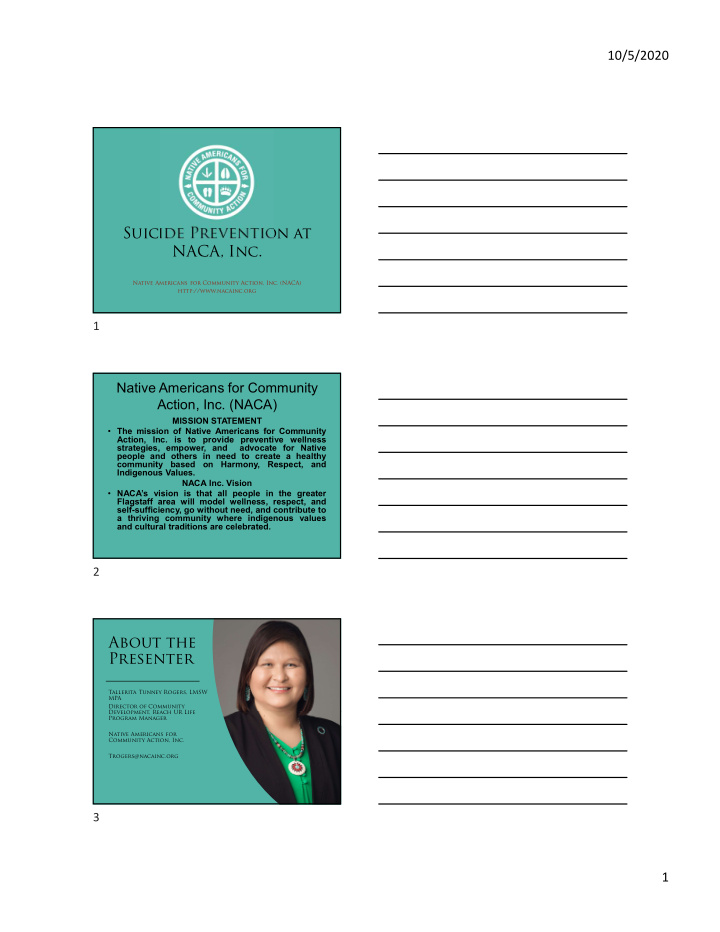



Tallerita Tunney Rogers, LMSW MPA Suicide Prevention at NACA, Inc. Native Americans for Community Action, Inc. (NACA) http://www.nacainc.org Presenter About the Director of Community Development, Reach UR Life Program Manager Native Americans for Community Action, Inc. Trogers@nacainc.org 10/5/2020 1 Native Americans for Community Action, Inc. (NACA) MISSION STATEMENT • The mission of Native Americans for Community Action, Inc. is to provide preventive wellness strategies, empower, and advocate for Native people and others in need to create a healthy community based on Harmony, Respect, and Indigenous Values. NACA Inc. Vision • NACA’s vision is that all people in the greater Flagstaff area will model wellness, respect, and self-sufficiency, go without need, and contribute to a thriving community where indigenous values and cultural traditions are celebrated. 2 3 1
10/5/2020 Learning Objectives • Participants will learn how NACA, Inc. is addressing Suicide Prevention. • Participants will learn the elements of whole system Suicide Prevention. • Participants will learn how the National Suicide Prevention Strategy and CDC Strategy on Suicide Prevention are whole-system interventions. 4 NACA, Inc. Suicide Prevention • Reach UR Life • Native Connections • Behavioral Health Department • Zero Suicide Framework (Zero Suicide Institute) – Focus on 7 elements – Policies and Procedures – PHQ-9 screening at Family Health Clinic 5 Suicide Prevention History at NACA Technical assistance - Zero Suicide Framework Suicide Prevention Trainings TA - Collaboration with NACA’s Native Connections program Data collection activities Workforce development For clinicians – clinical trainings For educators/youth-serving professionals – self care, etc. 6 2
10/5/2020 Zero Suicide Framework Toolkit 7 CDC Technical package • “a compilation of a core set of strategies to achieve and sustain substantial reductions in a specific risk factor or outcome” – Three components • Strategy: the preventive direction or actions to achieve the goal of preventing suicide • Approach: the specific ways to advance the strategy (programs, policies, and practices) • Evidence: activities that meet one of 3 criteria 8 National Suicide Prevention Strategies • Strategic Direction 1: Healthy and Empowered Individuals, Families, and Communities • Strategic Direction 2: Clinical and Community Preventive Services • Strategic Direction 3: Treatment and Support Services • Strategic Direction 4: Surveillance, Research, and Evaluation (HHS, September 2012) 9 3
10/5/2020 Whole system approach Systems theory: “that systems or organizations are characterized by order, rationality, and stability 10 CDC Suicide Prevention Strategies • CDC S1: Strengthen economic supports • CDC S2: Strengthen access and delivery of suicide care • CDC S3: Create protective environments • CDC S4: Promote connectedness • CDC S5: Teach coping and problem-solving skills • CDC S6: Identify and support people at risk • CDC S7: Lessen harms and prevent future risk 11 Strengthen economic supports (CDC S1) • Overlook/Economic Development Program • Supportive Services – Navajo Way Program (lodging assistance related to medical stays in Flagstaff) – Sack lunch program – Ceremonial Assistance, with Navajo United Way – Social Support Case Manager • Family Health Center – Patient Benefits Coordinator Correlates to NSPS SD 1: Healthy and Empowered Individuals, Families, and Communities 12 4
10/5/2020 Strengthen access and delivery of suicide care (CDC S2) • Organization-wide adoption of Zero Suicide policy • Behavioral Health (BH) Department and Family Health Center (FHC) screen for depression – PHQ-9 – PHQ-A • Brief Intervention Coordinator/Psychotherapist • RUL Suicide Prevention Program – Case Manager Correlates to NSPS SD2: Clinical and Community Preventive Services and NSPS SD3: Treatment and Support Services 13 Create protective environments (CDC S3) • Primary focus on reducing lethal means • Prompt response times in the form of Zero Suicide policies and culture • Correlates to NSPS SD2: Clinical and Community Preventive Services and NSPS SD3: Treatment and Support Services 14 Promote connectedness (CDC S4) • Community Engagement activities – All programs and departments – Community Development Department – Interdepartmental and Interorganizational collaborations – Use of evidence-based programming (SOS, CAST) – Life skills trainings Correlates to NSPS SD1: Healthy and Empowered Individuals, Families, and Communities and NSPS SD 2: Clinical and Community Preventive Services 15 5
10/5/2020 Teach coping and problem-solving skills (CDC S5) • BH – Groups – SA Talking Circle – Pathways after school program • Community Development – Supportive Services: COVID-19 Talking Circle – LIFE programming: Indigenous lifestyle – exercise, gardening, etc. – RUL: Life skills and Social skills (SOS, CAST) Correlates to NSPS SD1: Healthy and Empowered Individuals, Families, and Communities and NSPS SD2: Clinical and Community Preventive Services 16 Identify and support people at risk (CDC S6) • Suicide Prevention Trainings • Crisis Intervention – Brief Intervention Coordinator – Zero Suicide Initiatives • Treatment for risk of suicide – Screening – Referrals – Treatment with therapy Correlates to NSPS SD2: Clinical and Community Preventive Services and NSPS SD3: Treatment and Support Services 17 Lessen harms and prevent future risk (CDC S7) • Postvention – Bereavement groups (forthcoming) – Access to therapy • Youth Psychtherapists • Safe reporting and messaging • Organizational membership to American Association of Suicidology • Ongoing suicide prevention trainings Correlates to NSPS SD3: Treatment and Support Services and NSPS SD4: Surveillance, Research, and Evaluation 18 6
10/5/2020 Resources • U.S. Department of Health and Human Services (HHS) Office of the Surgeon General and National Action Alliance for Suicide Prevention. 2012 National Strategy for Suicide Prevention: Goals and Objectives for Action. Washington, DC: HHS, September 2012. • Stone, D.M., Holland, K.M., Bartholow, B., Crosby, A.E., Davis, S., and Wilkins, N. (2017). Preventing Suicide: A Technical Package of Policies, Programs, and Practices. Atlanta, GA: National Center for Injury Prevention and Control, Centers for Disease Control and Prevention. • Substance Abuse and Mental Health Services Administration. Preventing Suicide: A Toolkit for High Schools. HHS Publications No. SMA-12-4669. Rockville, MD: Center for Mental Health Services, Substance Abuse and Mental Health Services Administration, 2012. • Zero Suicide Institute. Zero Suicide Toolkit. Retrieved from https://zerosuicide.edc.org/about. 19 7
Recommend
More recommend